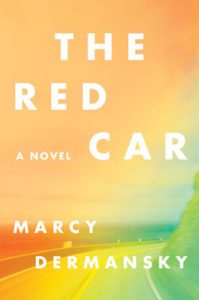
It seems like there are a lot of possessed automobiles in fiction: Christine is probably most famous, but there’s also Chitty Chitty Bang Bang (possession doesn’t always have to be evil) and Melmoth the Wanderer (Humbert Humbert’s station wagon in Lolita, possessed by that character’s dark desires, and also named for a gothic novel about a man in the Devil’s grip). If we include movies and TV we can add Herbie the Love Bug and KIT from Knightrider to the list. But the literary car that most reminds me of the one in Marcy Dermansky’s new novel, The Red Car, appears in Joy Williams’ short story, “Rot”. That car is a Thunderbird, glossy black on the outside but, as its new owners come to learn, possessed of a terminal case of rust. In “Rot”, a character named Dwight finds the T-Bird in a parking lot with a dead man inside and eventually buys it. “I knew I just had to have this car,” he tells his wife, Lucy. “This car is almost cherry,” he says. Lucy, much younger than her husband but practical to a fault, tells Dwight, “A man died in it. I would say that this car was about as un-cherry as you can get.”
We never learn the make or model of the car bequeathed to Leah Kaplan, the narrator of The Red Car, only that it’s red and sporty and somewhat incongruous with the personality of its original owner, who died driving it. When we meet Leah, she’s a young writer living in Queens with her doting but needy husband Hans, working at a telecommuting job to keep up with rent and bills. A few pages in, Leah learns that her erstwhile boss-cum-mentor Judy has been killed. The funeral is the next day, and since Judy has willed her the prized car and some money, Leah’s former coworkers urge her to attend. Faced with a choice, Leah isn’t sure how to react. Throughout the novel, Leah’s emotions are like runes she must interpret, her uncertainty about decisions catching up to her long after she’s made them. Dermansky writes refreshingly about the way we think, choose, and act in real life. Here is Leah on her decision to go to grad school:
I sometimes thought I applied… to avoid renting my own apartment. To get away from Daniel who I had actually lived with for an entire year. From the start it was understood that it was actually temporary, he was low on cash, and when he asked me to leave, I sublet a room for a couple of months in the Haight, and then another room out by the ocean, and then I left. I went down south, to Louisiana, of all places, where I received a fellowship.
Leah goes off to San Francisco not quite because she wants to, but because someone else pays for the tickets. She also realizes she wants to get away from Hans for a while, though she can only do so after a shockingly ugly confrontation that leaves her questioning whether she can remain in the marriage at all.
Leah is buffeted around the Bay Area by memories, by others’ desires, and by odd coincidences and omens. Even before she’s buried, Judy returns as a specter, a disembodied voice in Leah’s head offering a running commentary, along with bits of advice that seem trimmed from the lower branches of the self-help movement. “Have an open mind,” she tells Leah. “I am on your side.” Judy is Leah’s near-constant companion as she visits her old apartment, has a few brief sexual encounters, and spends time with old college friends, all the while trying to figure out, in the respite the trip has offered from the rest of her life, just how to have achieve the fulfillment Judy wanted for her. I never felt the novel fully committing to Judy as a ghost—her bromides are too close to what Leah might imagine Judy saying—and I might have written these episodes off as a gimmick to expose Leah’s unconscious if the book didn’t contain other elements of the supernatural.
Which brings me to the titular red car.
It’s no wonder writers are drawn to cars as receptacles for spirits looking to possess something. After all, we possess our cars, literally (through ownership; and also they can’t do much without us, at least not yet) and figuratively (so much of the American dream is tied to the automotive industry). And the vernacular attached to cars can be downright spooky. A car may “drive like a dream”; in our worst moments we suffer from “road rage” or drive “under the influence.”
Early on, Leah recalls her sense that the car is bad to the bone the day Judy proudly shows it to her:
The car was too low to the ground. It had a new car smell, something chemical and cloying, and I opened the window even though it was cold outside. “I feel like something sinister has happened in this car,” I said. “Or could happen. I don’t know. Something bad.”
Not long after Judy’s funeral, Leah visits the car at a mechanic’s shop to decide what she should do with it. She’s torn, as she often is—she loves Judy and wants to honor her memory by accepting this gift, but she’s never liked the car, always mistrusted it, and blames it for the death of her friend. Seeing it again doesn’t help:
I felt the margaritas turn in my stomach and I wondered if I would throw up… There I was, face-to-face with Judy’s red car. The entire left side was smashed in, the face of the car that had killed her imprinted in the metal.
But Leah winds up with the car after all. She even learns to accept its magical properties—its ability to self-heal (“The car fixed itself,” the mechanic tells her) and the hypnotic influence it exerts on whoever drives it. She takes the car to Palo Alto for a reunion with a college friend and attends a lecture by an old lover whose philanthropic startup, sort of a Go-Fund-Me for the arts that also helps women in third world countries, has made him millions. Leah tells us, “I wanted him to be evil. For him to be morally bankrupt, despicable. But when he came up on stage, he was just Jonathan Beene.” In her comparisons of herself to others, Leah forever seems to come up wanting.
After Palo Alto, she heads down Highway 1, which frightens her with its twists and turns. “If this were a Murakami novel,” she says, “at least I would be listening to the right music, a Beach Boys cassette or some old jazz, but I was too scared to take my hand off the wheel to turn on the radio.” She winds up pulling off the treacherous road into an inn, which just so happens to be the same place her parents stayed long ago. Although the few chapters set at the inn offer up some of Dermanskv’s most gorgeous prose, the setting offers Leah no escape from the confines of memory and consequence.
Toward the end, in one surprising scene, the novel answers the question of whether or not the red car will spirit Leah away to a revised life of creative and romantic fulfillment. But it leaves us with lingering questions about the choices we make. Can we ever claim to own them exclusively? Or are we at least partially possessed by the wishes imposed on us by the previous generation, by our particular privileges, by a multitude of invisible forces that drive us? Who are parents, teachers, mentors, if not possessors? Do we not all travel with ghosts whispering admonition, haunting our every move? With honesty and humor, The Red Car leads us to ask if we aren’t all just a little un-cherry.





